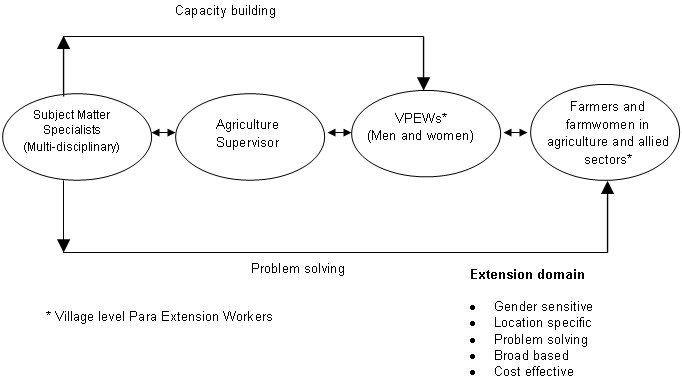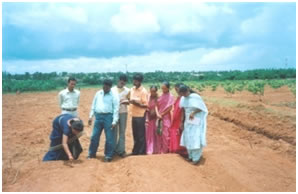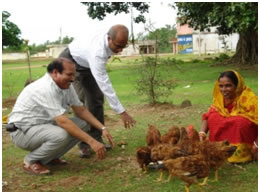Technologies for Women in Agriculture => Models & Methodologies
DESIGNING GENDER SENSITIVE EXTENSION MODEL AND TESTING ITS EFFICACY
Back ground
Need for gender sensitive extension in agriculture and allied fields has gained considerable importance at the national level to stream line extension services for farm women. The growing demand for agricultural extension services specially in gender perspectives at the local level coupled with resource crunch with the state governments have created a need for an alternate extension model which must incorporate the essential dimensions of extension. The report of working group on Gender issues, Panchayat Raj Institutions, Public Private Partnership, Innovative Finance and micro-finance in agriculture, Planning Commission, January 2007 for the Eleventh Plan (2007-2012) suggested to appoint village youths as para-workers for agricultural extension.
Technology description
The Central Institute for Women in Agriculture has begun efforts to test gender sensitive extension model with a focus on involvement of a group of Village level Para Extension Worker (VPEW) in extension. An attempt was made in such a way which can be accommodated in the existing institutional frame of the State and Central Government. To describe briefly it is a model in which the Village level Para Extension Worker (VPEW) is considered as the most important pillar to support the model. Keeping the above fact in view an extension model based on public-private partnership was developed to address gender sensitivity, cost effectiveness, leadership development among farmwomen, technological location specificity and subject matter support from specialists.
Schematic Gender Sensitive Extension Model

- The project should be taken up in an action research mode.
- Provision of honorarium/services charges for VPEW
- Required qualification for VPEW would revolve around gender biasness, skills in communication, physical vitality, background in agriculture, interest to serve the community and willingness to work with the scientists.
- Benchmark data should be collected through survey as well as on the ability of the Village level Para Extension Workers (VPEWs).
- All the Para Extension Workers should be provided pre-project as well as pre-seasonal trainings at the institution to give them exposures on basic methods of transfer of technologies in gender perspective
- The Para Extension Workers should give tips to render advisory services, advocacy, conduct discussion, meetings and organize methods and result demonstrations.
- Feedback and transfer of solutions were taken up through telephone calls and visits of Para Workers to the institution.
- The Subject matter specialists in their respective fields participate for capacity building of the Para Workers, test the gender sensitivity of the farm technologies and provide the solution to different location specific problems.
- The Technical Assistant/Supervisor implements the technical programs and monitors the activities of the Para Workers.
- Monitoring, concurrent evaluation, case studies, problem analysis, productivity analysis and group dynamics were taken up during the period of project implementation.
How it is women friendly?
- Balanced gender composition of VPEWs
- Assured women leadership development
- Equal participation of farm women as men
- Equal benefit of farm women as men
- Vigorous extension service towards women
- Gender sensitization of the clienteles
Performance:
- Excellent gender awareness in locality
- SC, resource poor women and WSHGs derive maximum benefits from the model
- Increase in skills of farm women in the areas of:- nutrition garden cum seed production, mushroom cultivation, value addition, plant protection, fish culture, ornamental fish farming, back yard poultry rearing and vegetable cultivation
- Additional income of farm women specially from mushroom, backyard poultry, small ruminants, fry production, vegetable production, floriculture, and rice production
- Improvement in nutrition, employment, , skill development, gain in knowledge and drudgery reduction
Locale of dissemination/ application:
- District: Khordha
Block: (i) Bhubaneswar (Padasahi and Tangibanta)
(ii) Begunia (Simore and Kantamalim)
Outcomes/impact/benefits:
- Gender sensitive extension model
- Gender sensitization among stakeholders
- Publications (research articles, leaflets, bulletins, etc)
- Success stories
Limitations if any
- Para workers may very easily quit their responsibilities
- May demand for higher honorarium or other benefits by threatening
- No job security for VPEWs
Photos
 |
 |
Source (author/organization):
B. N. Sadangi, Sabita Mishra, H. K. Dash, P. K. Sahoo, S. K. Srivastava, Abha Singh and Laxmi Priya Sahoo, ICAR-Central Institute for Women in Agriculture, Bhubaneswar, Odisha
Developed/tested/refined:
Developed and tested
Year and purpose:
2007-2010 for engendering agriculture extension
Cost:
Contingency: Rs 7.30 lakh
Patent/Commercialization:
Nil
Weather further study/ modification are required or not:
Yes, needs further replication in different locations for validation of the model.

